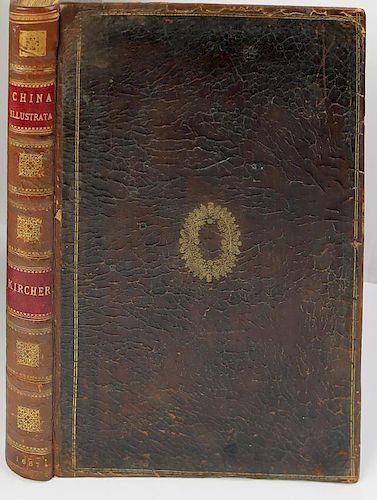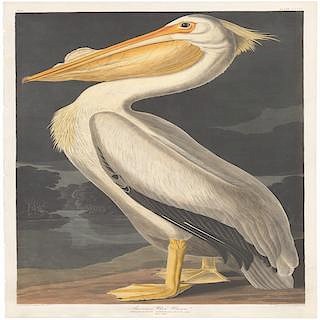Kircher, China Monumentis, First Edition, Rare Book
Lot 136
About Seller
Arader Galleries
1308 Walnut Street
King of Prussia, PA 19406
United States
Arader Galleries proudly celebrates over 40 years in the business of important, antique works on paper, paintings and rare books. W. Graham Arader III began his collection of rare maps, atlases and Americana while an undergraduate at Yale University, and today that passion has grown into one of the ...Read more
Estimate:
$4,000 - $6,000
Absentee vs Live bid
Two ways to bid:
- Leave a max absentee bid and the platform will bid on your behalf up to your maximum bid during the live auction.
- Bid live during the auction and your bids will be submitted real-time to the auctioneer.
Bid Increments
| Price | Bid Increment |
|---|---|
| $0 | $25 |
| $500 | $50 |
| $1,000 | $100 |
| $2,000 | $250 |
| $5,000 | $500 |
| $10,000 | $1,000 |
| $20,000 | $2,000 |
| $50,000 | $5,000 |
| $100,000 | $10,000 |
| $200,000 | $25,000 |
About Auction
By Arader Galleries
Mar 25, 2017 - Mar 26, 2017
Set Reminder
2017-03-25 13:00:00
2017-03-26 13:00:00
America/New_York
Bidsquare
Bidsquare : Arader Galleries Spring 2017 Auction
https://www.bidsquare.com/auctions/arader/arader-galleries-spring-2017-auction-2184
Arader Galleries loricohen@aradergalleries.com
Arader Galleries loricohen@aradergalleries.com
- Lot Description
China monumentis, qua sacris qua profanis, nec non variis naturae & artis spectaculis. Athanasius Kircher. (1602-1680). Amsterdam: Joannem Janssonium & Elizeum Weyerstraet, 1667. Folio (15 x 9 4/8 inches). Fine engraved allegorical frontispiece title-page, vignette title-page (marginal loss not affecting the letterpress), engraved portrait of the author, 2 double-page and folding maps "Imperium Sinicum Quindecupartitum" (one or two short marginal tears just entering the image), "Tabula Geodoborica Itinerum a varijs in Cataium ..." (detached, separations at folds), 2 large folding plates (one with early repairs to verso), 20 full-page plates, 61 engraved vignettes (that on page 157 pasted over existing engraving), some woodcuts in the text, wood-engraved initials and tail-pieces (some light spotting and browning). Contemporary calf covers, decorated with central gilt floral wreath (laid down in the late 19th-century on calf, the spine in gilt ruled and decorated compartments, red morocco lettering-pieces (quite worn with loss to the head of the spine). Provenance: with the engraved armorial bookplate of William Woodville Rockhill (1854 - 1914), Orientalist and diplomat, on the front paste-down. An understandably well-read copy of the first edition of this profusely illustrated account of China based on descriptions by many European explorers, including many Jesuits such as Kircher himself. The engravings are based on these explorers' sketches and original images imported from Asia. From the library of distinguished Orientalist W.W. Rockhill who "helped to shape American Far Eastern policy for several generations. He was instrumental in reframing the traditional and interrelated American principles of equal commercial opportunity and support for China's independence so as to meet the perceived threat to national interests from the crisis in China. He did this at a time when American leaders were seeking a domestically acceptable way to assert a larger U.S. role in world affairs. Rockhill understood that the political, economic, and financial dimensions could not be isolated, even as he insisted that the solution to the "Oriental question" rested on the preservation of a stable, independent China willing and able to carry out its obligations. While often frustrated by the ineptitude and duplicity of his diplomatic colleagues, Rockhill proved to be a "supreme realist," a tough bargainer, and a skilled diplomat in the service of his country. Finally, as a scholar, he represented the prototype of the foreign expert and the model for advocates of the professionalization of America's foreign policy apparatus" (Pugach ). "Rockhill's fame rests on his diplomatic career, but he was first and always a dedicated, pioneering, and prolific Orientalist. Whether he was uncovering and translating ancient Chinese and Tibetan classics or exploring remote parts of China and Tibet between 1888 and 1892, with amazing indifference to his personal safety, Rockhill was driven by the late nineteenth-century search for "objective," scientific truth and the love of knowledge for its own sake. Rockhill was one of a handful of Westerners to penetrate Tibet and Mongolia, and in 1908 he was honored by having several long conversations with the Dalai Lama, who sought the American's advice on his delicate relationship with the Manchu Court and Tibet's future. Over a period of thirty years Rockhill produced dozens of significant books, articles, and papers that vividly depicted the physical landscape and sought to understand Asian societies. Meanwhile, he deliberately cultivated his image as an authority on the Far East in an era that was beginning to recognize the need for professional expertise" (Noel H. Pugach for ANB). Honeyman V, 1824; Caillet 5773; Brunet III, 666; Merrill 20. Guidance: Bruun Rasmussen, 2009 - €6,955
- Shipping Info
-
Shipping Terms:Packing and handling of purchased lots by us or by someone else is at the entire risk of the purchaser. Purchasers are responsible for all packing and shipping costs.
We are not responsible for the acts or omissions of carriers or packers of purchased lots whether or not recommended by us.
-
- Buyer's Premium



 EUR
EUR CAD
CAD AUD
AUD GBP
GBP MXN
MXN HKD
HKD CNY
CNY MYR
MYR SEK
SEK SGD
SGD CHF
CHF THB
THB








